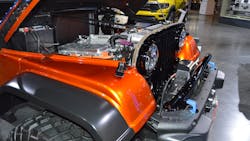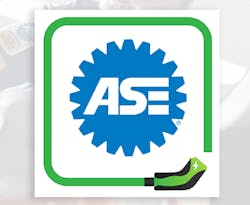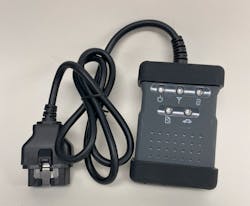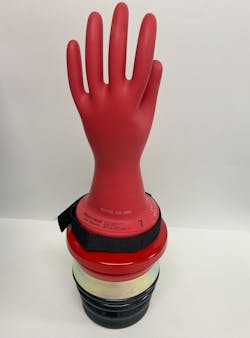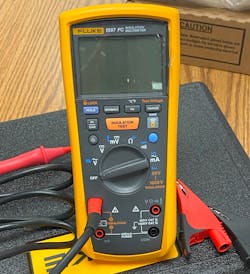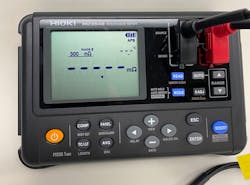Content brought to you by Motor Age. To subscribe, click here.
What You Will Learn:
• ASE offers voluntary certification for EV safety
• Factory scan tools and interfaces offer more capability than aftermarket J2534 devices, in many instances
• Safety, training, certification, and tooling will be required to prepare technicians and shops for the transition to electric vehicles (EVs).
The emergence of electric vehicle technology is evident. Lawmakers at the state and federal level have charted a course to a future that’s likely free of internal combustion engines, with aggressive mandates placed on auto makers that will result in a seismic shift in the automotive technology landscape. Is your shop prepared for the transition?
In 1959, Ray’s Auto Service opened on the north service road of Sunrise Highway in Islip, New York, just around the corner from Long Island’s iconic Islip Speedway. Ray Sr. bought the American Oil Company station that included a two-bay repair shop with the intention of setting up Ray Jr. in the auto repair business. The first day on the job, Ray Jr. learned how to set distributor points, change a cap and rotor, and set the gap on a spark plug. In a short time, Ray learned enough to run a successful repair shop and he was able to purchase a home and raise a family.
In 1969, Ray Jr. was forced to close the shop due to an expansion of the highway and took a job with a familiar company, Snap-on Tools. Over the course of his 25 years at Snap-on, he learned automotive technology the hard way, through on-the-job training and what little education was available at that time, and in 1990 he became a Snap-on Tech representative. I know this story well— as a 12-year-old kid I started riding around in the truck on summer vacations with my grandpa, Ray Jr.
Now at 90 years of age, Grandpa Ray and I recently had a conversation about electric vehicles, and he remarked how he could not conceive how a technician like him, with no experience and training could make it in a world of advanced technology electric vehicles. During the conversation, we discussed what would be required for technicians and shops to be successful in maintaining and repairing these vehicles. As he remarked, “This is truly not your grandpa’s automotive business any longer.”
One of the most staggering realizations about our automotive workforce is that there is no minimum standard for career entry. In 1972 The National Institute for Automotive Service excellence (ASE) was formed to professionalize the industry and provided a framework for voluntary automotive certification. Today, the automotive technician workforce is made up of roughly 733,200 workers (according to the Bureau of Labor Statistics). Of the 733,200, an alarming 3,409, or less than one percent of technicians, hold the ASE L3 Light Duty / Electric Vehicle Specialist certification. Overall, just 24 percent of technicians hold any certification through ASE. While the number of OEM certified technicians is unpublished, the percentage of those not holding certification brings to question the preparedness of the workforce.
This requires a closer look at the safety, training, certification, and tooling that will be required to prepare technicians and shops for the transition to electric vehicles (EVs) and other advanced technologies.
Safety considerations
A good starting point for those seeking to prepare for electric vehicle service and repair is an awareness of the safety issues related to EV high-voltage systems. In Spring 2023, ASE released new electric vehicle safety standards and certifications that cover the essentials of electric vehicle safety awareness.
The xEV Electrical Safety Awareness Certification (Level 1) is intended for anyone working around electric vehicles in a shop environment including sales, service, and related personnel.
The xEV Technician Electrical Safety Certification (Level 2) is intended primarily for technicians who are responsible for maintaining and repairing electric vehicles.
These certifications and standards are available via the web at: https://www.ase.com/ev and are priced at $38.99 and $49.99 respectively.
These tests can also be taken anywhere in which there is web access, and the test-taker does not need to visit a computer-based testing center. The test has a 60-minute limit and when successfully passed the site will generate a downloadable, print-ready certificate.
Training
As with any new technology, technical training for EV’s is essential. Currently, EV training is available from auto parts companies, technical and career and education providers such as community colleges and trade schools, and independent training entities.
As with any training, look for affiliation with accrediting bodies that align with automotive technician training standards such as ASE. ASE’s Training Manager Council (ATMC) provides training organizations with an accreditation that is rigorous and ensures that the training provider, its material, and its trainers are qualified.
A list of ATMC accredited training providers can be found on the ATMC website: https://atmc.wildapricot.org/
Keep in mind that any high voltage training requires a fundamental understanding of electricity and electronics. If you are planning on servicing high-voltage vehicles, start with the basics. Seek training that will build your electrical and electronics skills. Understanding the fundamentals will make the transition to high-voltage AC and DC current much easier.
Certifications
A certification can be defined as a credential provided by a third-party industry-recognized entity that provides a measurement of competency in a given area. Keep in mind, certifications are different than certificates of completion. Simply completing a course or attending a training class does not result in certification, even though you may have been given a certificate at the end.
The two main industry-recognized certifications in the automotive repair sector are OEM specific certifications and ASE certifications. OEM certifications require that a technician work for the brand in order to earn certification, or they can also be obtained in OEM training programs at trade schools and community colleges.
ASE is an independent voluntary certification available to any technician who possesses two years of industry experience and who takes and passes the certification exam. There is no training required as a pre-requisite to certification although ASE strongly recommends training before certification.
ASE’s L3 Light Duty Hybrid / Electric Vehicle Specialist Test is the industry standard for hybrid/electric vehicle certification. To take the L3 exam, a technician must first possess the ASE A6 Electricity and Electronics and A8 Engine Performance Certifications.
Recently, a National Science Foundation grant at Central Oregon Community College created a set of safety and technical standards for EVs. This grant resulted in the formation of EV Pro Plus, an organization that provides training leading to a certification and is registered with a division of the society of automotive engineers (SAE) known as SAE-ITC. The EV Pro Plus certification has four levels that include several days of classes and hands-on testing which are required before taking the certification exam through SAE-ITC’s website. The EV Pro Plus SAE certification is unlike ASE certification in that it is not independent of the training provided by EV Pro Plus. In other words, you must first complete the training provided exclusively by EV Pro Plus to qualify for the examinations for each level. For more information on the program visit: https://www.evproplusprogram.com/
Factory service information and diagnostics
As technology advances, the complexity of the repairs we will take on will follow. It may become essential to have access to the latest, most up-to-date information and tooling in order to perform service, diagnostics, and repair.
Most manufacturers have a subscription to service information and diagnostics available through an independent service website. The National Automotive Service Task Force (NASTF) is a great place to start with your search for assistance in obtaining factory information and diagnostics.
OE scan tool interfaces are also available to use in conjunction with the factory software through vendors such as Drew Technologies, AE Tools, NC Auto Rescue, and AES Wave.
Tools and equipment
Many of the tools that you currently use will remain in use for electric vehicles. However, there are quite a few new tools and equipment required for electric vehicle diagnosis and repair.
Personal protective equipment (PPE)
Class “0” linesman gloves are required when performing a high-voltage system service disconnect and at any time specified by the service information.
These gloves are available from a variety of retailers and typically come as a set that includes high-voltage gloves and leather over-shell gloves that are worn over the insulated gloves.
These Class 0 gloves require certification every six months, which includes mailing the gloves to a certified testing center. At the time of recertification, the gloves will be date-stamped, starting the next six-month window.
An insulated retrieval hook (or “hot stick”) should be purchased for the facility. This special hook is used to rescue an electric-shock victim. A victim’s physical response to being shocked by high-voltage will be to increase their grip, so the “hot stick” or retrieval hook allows the rescuer to safely remove the victim from the hazard.
Physical barriers, signage and boundary guarding should be acquired to properly mark vehicles in service and make those around the shop aware of the hazards of an electric vehicle. A physical barrier should be used to restrict work areas around the vehicle to prevent unwanted interference by unaware individuals that could affect the safety of the work area.
Lockout or tagout boxes should be used when deactivating the high-voltage system. These lockable boxes should be used to store high voltage fuses or manual disconnects as well as vehicle keys so that the system is not accidentally energized.
Insulated hand tools may be used when servicing components of the high-voltage system. While these are not required, they are strongly suggested to protect the worker as well as the vehicle from high-voltage currents.
Meters and test equipment
The majority of professional automotive multimeters are typically suitable for electric vehicle testing and diagnosis providing that the meter and the meter leads meet the Category III – 1000 volt working voltage standards. Keep in mind, if working on higher voltage charging infrastructure you may need a Category IV meter.
Proving unit - To verify proper operation of your multimeter, a proving unit provides a battery supplied voltage that can then be measured by your meter before connecting to a vehicle and afterwards, to verify meter accuracy and ensure the voltage levels at the vehicle are safe to come in contact with.
Megohmmeter - The megohmmeter, or insulation meter, functions in a very similar fashion to the resistance or diode check feature on your traditional DMM. These features use a current that is sent through the leads to determine a voltage drop which is then displayed as a unit of resistance, measured in Ohms.
The traditional multimeter does not produce enough voltage or current to truly load the circuit. The resistance or ohms function uses approximately 2-3 volts and relatively low current. This amount of current is not nearly enough to properly test the high-voltage (HV) system’s insulation. The Megohmmeter provides a high-voltage/ low current output to properly test the motor-generator (MG) units and other HV components found on hybrid and electric vehicles.
Think of these tests as you would a pressure test of a hydraulic circuit. If you were to pressure-test a hydraulic circuit, you would most likely pressurize the system more than the system pressure rating to determine if there are leaks in the system. The insulation of HV systems is very similar to that of a hydraulic system and insulation of the wire is very much like the hose or pipe that carries the hydraulic pressure.
If the electrical pressure compromises the insulation, a faulty reading will be displayed on the meter. For the sake of your safety, do not attempt to test these circuits while the HV system is operational. Follow the manufacturer’s instructions and perform your testing accordingly. Be sure to use Class “0” rated gloves as required by service information.
Milliohmmeter - Much in the way that the DMM was limited in its ability to test high resistance values, the DMM also cannot measure very small resistance values. Milliohm meters offer the ability to measure resistance between phases of the MG units when dealing with trouble codes relating to the MG units.
The main difference between the megohmmeter and the milliohmmeter is that the milliohmmeter is designed to read a very small amount of resistance. To get a precise reading, the milliohmmeter uses a 4-wire resistance measurement, in which two of the wires pass the current through the circuit while the other two wires make the delta (difference between two points) voltage measurement.
Like any inrush of new technology, we as automotive technicians have faced in the past, EV will surely initially challenge us as we begin to grow and adapt to it. But waiting for the wave to pass is not an option, because EV is here to stay. We have to prepare now. If you fail to plan, you are indeed planning to fail.
